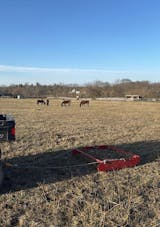
With temperatures finally dropping, equestrians everywhere are preparing for the arrival of winter.
Riding in the winter can be quite magical, but it’s crucial to ensure that you are taking all necessary steps to ensure that your horse is properly cared for during those cold winter months.
Here’s some information that will help you with your winter horse management.

Rugging
Ensuring that you’re correctly rugging your horse is an essential part of their winter care.
Keeping an eye on the weather on a daily basis is important; you want to avoid blanketing your horse with a rug that is not made for the weather that you are experiencing.
A rug that is too thin or light can lead to your horse being too cold, and a rug that is too heavy or thick can lead to overheating.
- Lightweight turnout rugs provide warmth for clipped horses in temperatures ranging from 40-50 degrees, and unclipped horses in temperatures ranging from 30-40 degrees.
- Medium turnout rugs are to be used for clipped horses in temperatures ranging from 30-40 degrees, and unclipped horses in temperatures ranging from 20-30 degrees.
- Heavy turnout rugs provide adequate warmth for clipped horses in temperatures ranging from 20-30 degrees, and unclipped horses in temperatures ranging from 10-20 degrees.

Hoof Care
Have your farrier come out in the fall to ensure that your horse’s hooves are trimmed and healthy, and that all shoes are in good shape.
In the case that any bad weather comes through, you will be able to rest assured knowing that you won’t have to worry about your horse throwing a loose shoe or splitting a hoof.
Large amounts of snow and fluctuating temperatures lead to large amounts of mud, which can cause issues in the hooves such as thrush or abscesses.
Make sure that your horse is not spending an excessive amount of time in the mud and snow.
Make sure to check the back legs of your horse for evidence of mud fever, and to dry them with a towel if they are damp or wet.
When you bring them into their stall, make sure that they have plenty of warm and dry bedding.

Feeding
Fiber digestion helps your horse regulate their body warmth.
As the weather gets colder, you may want to adjust the amount of forage they are given to help them regulate their body temperature and stay warm.
Of course, increased forage consumption can pose issues for impaction if not properly managed.
Make sure you increase their water intake; providing them with a salt lick can help encourage them to stay hydrated, as well.

Staying Hydrated
Most cases of equine dehydration occur in the winter.
Make sure that water buckets are monitored throughout the day to ensure that they have not become frozen, and invest in rubber buckets to avoid issues with cracking due to temperature extremes.

Clipping
Heavy winter coats can take quite a while to fully dry, which can pose a risk to your horse.
Clipping the coat is a great way to ensure that all moisture is able to fully dry from the coat.
If you choose to clip your horse’s coat in the winter, make sure that you adjust their blankets accordingly to make sure that they are able to stay warm.
Winters can be tough, but equestrians are well-known for being even tougher. Following these tips, you’ll be well-equipped to keep your horse healthy and happy this winter.
For more informative equestrian blog posts, check out our blog.
To browse our inventory of paddock cleaning tools, click here.




























